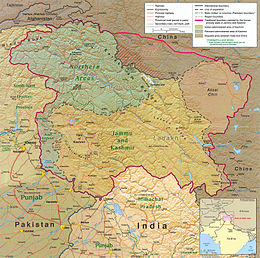| Part of a series on the |
| Constitution of India |
|---|
 |
| Preamble |


Article 370 of the Indian constitution[a] gave special status to Jammu and Kashmir, a region located in the northern part of the Indian subcontinent and part of the larger region of Kashmir which has been the subject of a dispute between India, Pakistan and China since 1947.[4][5] Jammu and Kashmir was administered by India as a state from 17 November 1952 to 31 October 2019, and Article 370 conferred on it the power to have a separate constitution, a state flag, and autonomy of internal administration.[6][7]
Article 370 was drafted in Part XXI of the Indian constitution titled "Temporary, Transitional and Special Provisions".[8] It stated that the Constituent Assembly of Jammu and Kashmir would be empowered to recommend the extent to which the Indian constitution would apply to the state. The state assembly could also abrogate the Article 370 altogether, in which case all of Indian Constitution would have applied to the state.
After the state constituent assembly was convened, it recommended the provisions of the Indian constitution that should apply to the state, based on which 1954 Presidential Order was issued. Since the state constituent assembly dissolved itself without recommending the abrogation of Article 370, the article was deemed to have become a permanent feature of the Indian Constitution.[9][10]
On 5 August 2019, the Government of India issued a Presidential Order superseding the 1954 order, and making all the provisions of the Indian constitution applicable to Jammu and Kashmir. The order was based on the resolution passed in both houses of India's parliament with two-thirds majority.[11][12][13][14] A further order on 6 August made all the clauses of Article 370 except clause 1 to be inoperative.[15]
In addition, the Jammu and Kashmir Reorganisation Act, 2019 was passed by the parliament, enacting the division of the state of Jammu and Kashmir into two union territories to be called Union Territory of Jammu and Kashmir and Union Territory of Ladakh.[16][17][18] The reorganisation took place on 31 October 2019.
A total of 23 petitions were presented to the Supreme Court of India, challenging the constitutionality of the abrogation of Article 370 of the Constitution, which constituted a five judge bench for the same.[19][20][21] On 11 December 2023, a five judge constitution bench unanimously upheld the constitutionality of the abrogation of Article 370 of the Constitution.[22]
- ^ Noorani, Article 370 2011, Introduction, p. 4.
- ^ Article 370 and the Constituent Assembly Debates Archived 6 February 2023 at the Wayback Machine, constitutionofindia.net, retrieved 20 January 2022.
- ^ Bose, Sumantra (2003), Kashmir: Roots of Conflict, Paths to Peace, Harvard University Press, p. 59, ISBN 0-674-01173-2
- ^ Akhtar, Rais; Kirk, William, Jammu and Kashmir, State, India, Encyclopaedia Britannica, retrieved 7 August 2019 (subscription required) Quote: "Jammu and Kashmir, state of India, located in the northern part of the Indian subcontinent in the vicinity of the Karakoram and westernmost Himalayan mountain ranges. The state is part of the larger region of Kashmir, which has been the subject of dispute between India, Pakistan, and China since the partition of the subcontinent in 1947."
- ^ Osmańczyk, Edmund Jan (2003), Encyclopedia of the United Nations and International Agreements: G to M, Taylor & Francis, pp. 1191–, ISBN 978-0-415-93922-5 Quote: "Jammu and Kashmir: Territory in northwestern India, subject to a dispute between India and Pakistan. It has borders with Pakistan and China."
- ^ Article 370: India strips disputed Kashmir of special status, BBC News, 5 August 2019.
- ^ K. Venkataramanan (5 August 2019), "How the status of Jammu and Kashmir is being changed", The Hindu, archived from the original on 8 August 2019, retrieved 5 August 2019
- ^ "Article 370: 10 facts that you need to know : Highlights, News – India Today". Indiatoday.intoday.in. 28 May 2014. Retrieved 18 August 2014.
- ^ The importance of Article 370, The Hindu, 15 October 2015.
"Article 370 is permanent, rules J&K High Court". The Hindu. Retrieved 25 March 2017. - ^ Cite error: The named reference
TOI 2018was invoked but never defined (see the help page). - ^ "Parliament approves Resolution to repeal Article 370; paves way to truly integrate J&K with Indian Union". pib.gov.in.
- ^ Cite error: The named reference
Venkataramananwas invoked but never defined (see the help page). - ^ Article 370 rendered toothless, Article 35A ceases to exist, The Economic Times, 5 August 2019.
- ^ "The Gazette of India" (PDF). Retrieved 6 March 2020.
- ^ Cite error: The named reference
inoperativewas invoked but never defined (see the help page). - ^ "Jammu and Kashmir Live News: Article 370 to be revoked, J&K to be reorganised". 5 August 2019.
- ^ "Kashmir debate LIVE: LS passes Bill reorganising Jammu and Kashmir". 6 August 2019.
- ^ "Article 370 Live News: Lok Sabha passes bill to bifurcate J&k, a step closer to becoming a law". 6 August 2019.
- ^ "SC to examine legal challenge to abrogation of Article 370; refers matter to 5-judge Constitution bench". The Times of India. 28 August 2019. Retrieved 19 March 2021.
- ^ "Article 370 matter stays with 5-judge bench, SC accepts govt's stand". Hindustan Times. 2 March 2020. Retrieved 19 March 2021.
- ^ Scroll Staff (2 March 2020). "Article 370: Supreme Court refuses to refer pleas challenging J&K decision to larger bench". Scroll.in. Retrieved 19 March 2021.
- ^ Krishnadas Gopal (11 December 2023). "SC upholds abrogation of Article 370, says move was part of 70-year-old exercise to integrate J&K to the Union". The Hindu. Retrieved 14 December 2023.
Cite error: There are <ref group=lower-alpha> tags or {{efn}} templates on this page, but the references will not show without a {{reflist|group=lower-alpha}} template or {{notelist}} template (see the help page).